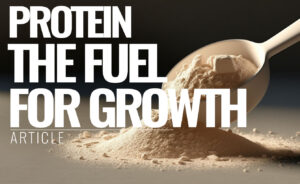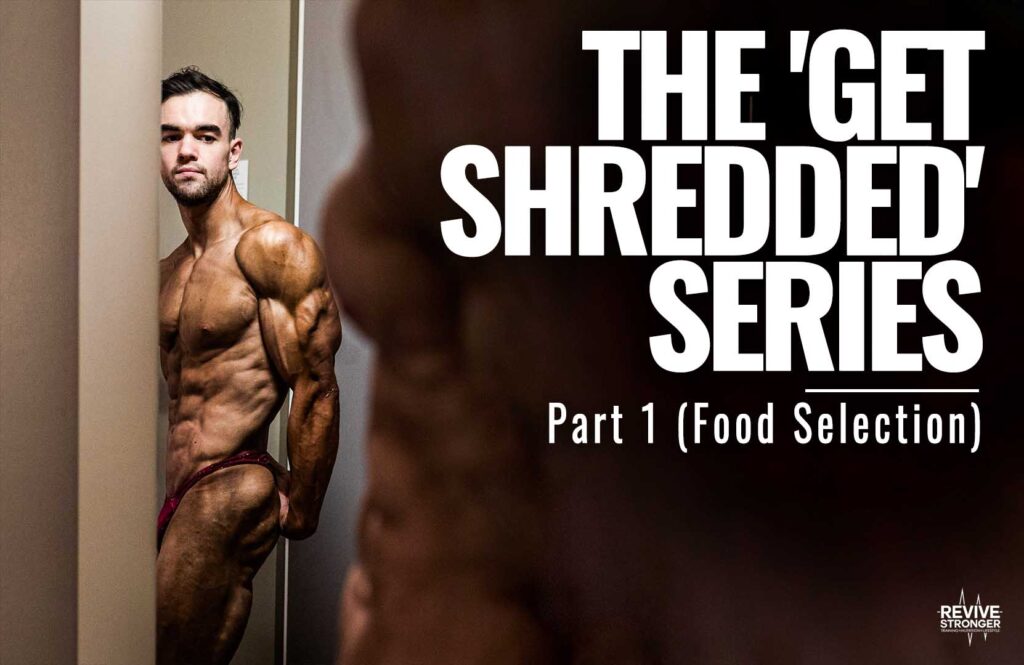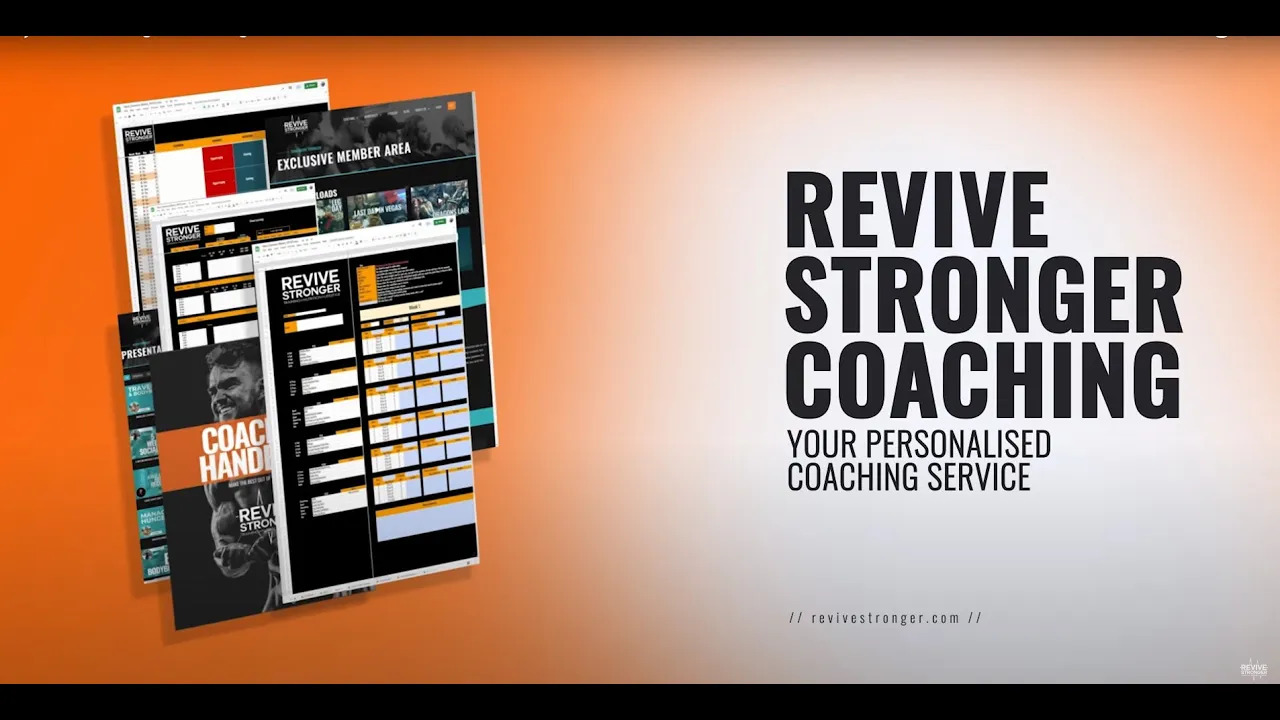
Revive Stronger
The ‘Get Shredded’ Series – Part 1 (Food Selection)

Are you trying to lose fat?
But finding it hard?
You know you need to be in a calorie deficit, you’ve made your tailor-made diet. You’re also helping yourself out by following a Flexible Diet. So on paper you’re going to succeed, all you need to do is follow the plan.
But, you’re constantly hungry.
You feel deprived.
You can’t get food out of your head, you feel empty inside and fed up.
Sticking to the plan is hard, and you need some help, you need some foolproof ways to lose fat.
I’ve been there, in 2014 I dieted for a very long time to get to very low body fat levels to compete as a Natural Bodybuilder (read more). The following fat loss series is going to go over some of the strategies I used to get ripped and still use with my clients to this day. You can see my journey documented in the playlist below.
The strategies I present to you today are not only powerful for keeping you on your diet, but they can also be extremely useful when trying to maintain weight because today everything I present you is about promoting fullness.
No I am not going to give you the 10 foods you must eat to lose fat, some of the foods I am going to suggest might go completely against everything you have heard. It damn right annoys me when people claim certain foods are inherently fattening, when some of those foods could actually really help you get shredded. This is why Flexible Dieting is a must when it comes to getting really lean and keeping that way, because without it you might not allow yourself to eat some of the most beneficial foods out there.
Table of Contents
Eat Big Portions
Managing portion size is important when it comes to getting shredded, but it doesn’t necessarily mean you can’t eat big. A great way to full yourself up is by selecting foods that don’t contain many calories for their size. They are calorie sparse, and therefore you can eat a lot of them. That’s a great way to help keep you satisfied and stop you going over your calorie goals.
[bctt tweet=” when dieting pick foods that have a low calorie content per bite”]
It works for two main reasons:
- They fill up your stomach and this sends fullness signals to your brain.
- Psychologically you feel fuller, because the size of your meals may not need to decrease.
So two diets that are equal in calories could be quite different in terms of how well they keep you full. The fuller you feel while dieting, the better chances are you will stick to your plan and drop the fat. This works so well there has even been a whole diet based around high volume foods called Volumetrics. So you might not be able to stuff your face with food, but you can still get in a lot by reducing the number of calories per bite.
You see the above two plates, they both contain the same total calories, but one has much more food. It’s pretty clear which one would be more satisfying to eat when consuming low calories. During my contest prep for natural bodybuilding most of my meals looked like the one on the right, full of low calorie foods. The reason these foods are low in calories is due to their high water content – water contains no calories, so adds calorie free bulk. In addition they are normally low fat (as fat has 9kcals per gram) and high in fibre (as fibre has 2-4kcal per gram).
Over the course of a day people tend to eat a similar amount of food by weight, so by choosing foods lower in calorie density we can eat more food, feel full, improve nutrient intake while at the same time revealing those all-important shreds. Combine this with your tailor made diet plan and you really have a strong fat loss strategy. By ‘eating big’; consuming calorie sparse foods you should be able to stick to your calorie deficit while remaining satisfied.
Fibre; not just for Pooping
That’s right fibre has more purposes than just keeping you regular, it can help keep you full too. This is because of two main reasons:
- Low Caloric Density
- Slowed Digestion
So most foods high in fibre are also low in calories per bite, so they help you eat big for few calories. In addition because of the way fibre reacts in our gut; to form a thick gel it slows digestion. If you have ever used Xanthum gum, then you know what I mean, because when you put that into shakes it really thickens them up.
A review study found that an additional 14g of fibre a day was linked to a 10% lower calorie intake and consequently weight loss of 2 kg over 4 months. In fact countless studies have been conducted both calorie controlled and not, in either case those on higher fibre diets saw more total weight lost. Obviously if calories are matched then you’d expect maybe a little more weight to be lost via your poop, but not enough to be significant, so the authors put it down to the fact the higher fibre dieters were more compliant, which is key to dieting success (in fact it is what this article is all about!).
Personally, I know if I eat a bowl of kids cereal over a bowl of oats, even if the cereal fills the bowl more, the oats will keep me fuller for longer. So high volume foods may not always be the key to keeping hunger away, there is a balance to be struck. Another reason the slowed digestion is important is because when we get to the really low calories, what you might have heard being called Poverty Macros, our fat intake is low. Diets low in fat are associated with chronic hunger which may be due in part to less fat in the intestine available for stimulation of fullness. By consuming a relatively high fibre diet we slow the digestion of fats, thereby increasing satiety. So if you are on a low fat diet or eating a low fat meal, fibre is going to really help you stay full.
Plus as you might expect we don’t absorb all of the calories from fibre, due to it being so hard to digest. It has been estimated we only get around 40% of the calories provided, another bonus of high fibre foods.
Furthermore, the textural qualities of some high fibre foods may increase the effort and time required for munching. This increase in chewing effort and time may result in a variety of responses and signals, leading to early fullness and therefore reduced food intake.
The Power of Protein
Protein is arguably the most important macronutrient to get right when dieting. This is because it helps us maintain our lean muscle tissue, often when people diet they do not get sufficient protein and so they lose a lot of muscle. Apart from sucking because you have to work hard for muscle, it also makes losing fat harder as muscle uses more energy than fat, thus their Basal Metabolic Rate (BMR – calories burnt at rest) goes down. This is why weight loss isn’t good, and fat loss is key.
[bctt tweet=”Protein is arguably the most important macronutrient to get right when dieting. “]
Another benefit of protein is that is has a higher Thermic Effect of Food (TEF) than carbs or fat, which means when it is consumed quite a lot of energy is lost via digestion (between 20-30% vs. 0-3% for fat & 5-10% for carbs). This is great when we are on a diet, because we can keep our calories level but bias them towards protein and increase our total calorie burn. I would note this probably isn’t substantial, but it can certainly help aid our journey to shredsville.
Furthermore, protein is also the most filling of all the macronutrients. One study had people consume 68% of their food from protein and others only 10%, the group eating the higher protein meal were kept fuller for longer. This is a consistent finding in the literature, and a powerful take home message that is high protein meals/diets are better at keeping you full. Normally I consume around 1g of protein per pound of my bodyweight, however when dieting this was taken higher closer to 1.3g. I found this really helped keep my hunger levels under control.
What protein should you go for? Well this can actually have an impact on how filling the protein is, you may want to shoot for dairy proteins that are high in casein content. Why? Because casein does this funny thing when it is digested, it coagulates, which basically means it gets all lumpy and thick, making digestion slower. If you are aware of any protein dessert type supplements, or had a casein protein shake they are thick partly because of this important characteristic of casein proteins. I regularly ate 0% Fat Greek Yoghurt as a snack in my contest prep, topped with some high fibre berries and a bit of calorie free sauce and I was golden.
How much protein? Check your tailor made diet.
Eat ‘Non-Hunger’ Foods
Satiety is the state in which we don’t eat because we’re full from what we have consumed previously, we are in a state of ‘non-hunger’. The Satiety Index is a measure of this, basically it ranks foods in order of how much they fill you up, from very filling, to it didn’t even touch the sides. Therefore, it is a brilliant tool to use for selecting foods when dieting, because two foods could be equal in calories but one could be much more filling.
The index was set with white bread being scored 100, anything getting more than 100 is more filling than white bread, anything below is less filling. Obviously this had to be controlled, as you could eat a bowl of ice cream and be more full than eating say an apple, but that’d also be a lot more calories. So the test was based on 240 calories of the particular food.
You may have guessed but foods that have low caloric density, are high in fibre and protein, can be found quite high up on this list. For example a boiled white potato, probably shunned by a lot of low carb dieters (although carbs are misunderstood) is actually very high on the satiety index and is 3 times more filling than white bread, lean beef can also be found high up on the scale.
Your Food List
What this all boils down to then is a selection of recommended foods that are high in bulk, fibre & protein and near the top of the satiety index. So you can stuff your face and keep full, so you don’t even feel like you’re dieting for the most part. That is the key to consistency and with consistency comes results, or shreds in our case.
- Rolled Oats (Try double cooking them, I even got to cooking them 5 times or more in contest prep)
- Plain Boiled Potato (salt & pepper makes a big difference)
- Greens (spinach, lettuce, kale, cucumber, courgette etc.)
- High fibre cereal (All-Bran, Fiber One, Grape Nuts, Puffed Wheat, Alpen light bars etc.)
- Fresh Fruit (especially; oranges, apples, berries, pears etc.)
- Lean Beef & Fish
- Beans (any variety but my favourite are refried beans)
- Protein Fluff
- Fibrous Vegetables (broccoli, cauliflower, squash etc.)
- Protein Mug Cake
- Low Calorie Noodles (Miracle Noodles, Shirataki Noodles etc.)
- Popcorn (go for the lower calorie varieties e.g. Proper Corn)
- Sugar Free Jelly with Berries
- 0% Fat Greek Yoghurt with Fruit
- Brown Rice & Pasta (plus a lean protein & fibrous vegetables)
- Egg whites with a Fibrous vegetable (a staple breakfast)
Did I say eat WHITE POTATO on a diet? Yes. I also told you to eat fruits and even cereal, yeah processed cereal. The food list above is not all the filling foods out there, in fact I want you to go and discover more. Again that is the great thing about allowing yourself to eat a varied diet, you can find which foods work best for you.
Of course none of this is helpful on its own, because that list are just foods that will help keep hunger at bay. The list doesn’t tell you anything about the nutrients each food provides, so they need to be eaten within your Tailor Made Diet Plan otherwise they won’t bring about the desired results. For example, if you want to keep your muscle then getting sufficient protein is vital, but also you want to keep carbohydrates high enough to promote performance and then you need to ensue you get your essential fats in for health and function. However, when the above information is used in combination with a goal driven nutrition plan you will see great results.
Thanks for reading Part 1 of the ‘Get Shredded’ Series, and stay tuned for further methods on getting lean.
Don’t want to miss a post? Sign up to my newsletter (you will also be treated to a free nutrition, training & supplement guide – seriously good stuff).
Click Here for Part 2 – Your Get Shredded Environment
References
- B, Burton-Freeman. Dietary Fiber and Energy regulation. The American Society for Nutritional Sciences (2000)
- Rolls, B. J., Castellanos, V. H., Halford, J. C., Kilara, A., Panyam, D., Pelkman, C. L., Smith, G. P. & Thorwart, M. L. (1998) Volume of food consumed affects satiety in men. Am. J. Clin. Nutr. 67: 1170–1177. Nutr Rev. 2001 May;59(5):129-39.
- Satiety Index of Common Foods.
- M. Veldhorst, A. Smeets, S. Soenen, A. Hochstenbach-Waelen, R. Hursel, K. Diepvens. Protein-induced satiety: Effects and mechanisms of different proteins , Department of Human Biology of the Nutrition and Toxicology Research Institute Maastricht (NUTRIM), Maastricht University, The Netherlands
- M. Lejeune, N. Luscombe-Marsh, M. Westerterp-Plantenga Received 15 October 2007; received in revised form 7 January 2008; accepted 8 January 2008
- Tyler A. Churchward-Venne, Caoileann H. Murphy, Thomas M. Longland ,Stuart M. Phillips. Role of protein and amino acids in promoting lean mass accretion with resistance exercise and attenuating lean mass loss during energy deficit in humans. Received: 12 December 2012 / Accepted: 25 April 2013
- Eric R Helms, Alan A Aragon and Peter J Fitschen. Evidence-based recommendations for natural bodybuilding contest preparation: nutrition and supplementation. Journal of the International Society of Sports Nutrition 2014, 11:20 doi:10.1186/1550-2783-11-20
- Nancy C. Howarth, M.Sc., Edward Saltzman, M.D., Susan B. Roberts, Ph.D. Dietary Fiber and Weight Regulation. May 2001: 129-139
We are a personal coaching service that helps you achieve your goals. We want you to become the best version of yourself.












Comments are closed.